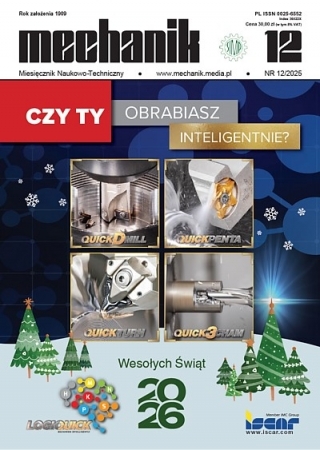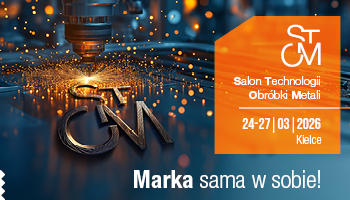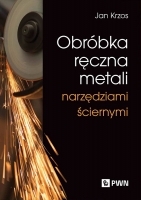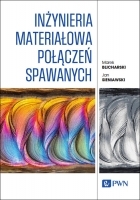Analiza stanu wiedzy i techniki w zakresie szlifowalności stopów na bazie niklu
State of the art in grindability of the nickel-based alloys
Mechanik nr 08/09/2015 - Wersje autorskie artykułów z XXXVIII Naukowej Szkoły Obróbki Ściernej zamieszczone na płycie CD
STRESZCZENIE: W artykule przedstawiono stan wiedzy i techniki w zakresie szlifowania superstopów niklu. Główny nacisk położono na zjawisko adhezji oraz na defekty szlifierskie jakie towarzyszą obróbce tego typu materiałów. Opisano również metody przeciwdziałania tym niepożądanym zjawiskom potwierdzone własnymi badaniami.
SŁOWA KLUCZOWE: szlifowanie, adhezja, defekty szlifierskie, impregnacja, superstopy niklu
ABSTRACT: This article describes the state of the art. In grindability of the sickle-based alloys. The main objective of this article is to describe two typical phenomena like adhesion wear and grinding defects in the process of grinding. The methods to counteract of this phenomena concurred with own research were also described.
KEYWORDS: grinding, adhesion wear, grinding defects, treatment, nickel-base superalloys
BIBLIOGRAFIA / BIBLIOGRAPHY:
- Praca zbiorowa, Poradnik fizykochemiczny, Warszawa: WNT, 1974.
- L. A. Dobrzański, Metalowe materiały inżynierskie, Gliwice - Warszawa: Wydawnictwa Naukowo-Techniczne, 2004.
- Nickel Develpoment Institute, „http://www.nickelinstitute.org/,” 23 marzec 2015. [Online]. Available: http://www.nickelinstitute.org/.
- D. Agarwal, "Nickel and Nickel Alloys," in The Handbook of Advanced Materials. Enabling New Designs, Hoboken, New Jersey, John Wiley & Sons, 2004, pp. 217-270.
- F. C. Campbell, Element of Metallurgy and Engineering Alloys, ASM International, 2008.
- P. Sutowski, „Proces szlifowania powierzchni płaskich przedmiotów z materiałów trudno skrawalnych,” w Wysoko efektywne szlifowanie materiałów trudno skrawalnych, Koszalin, Wydawnictwo Uczelniane Politechniki Koszalińskiej, 2012, pp. 178-205.
- J. Plichta, „Charakterystyka materiałów trudno skrawalnych,” w Wysoko efektywne szlifowanie materiałów trudno skrawalnych. Monografia nr 225, J. Plichta, K. Nadolny, W. Musiał i P. Sutowski, Redaktorzy, Koszalin, Zachodniopomorskie: Wydawnictwo Uczelniane Politechniki Koszalińskiej, 2012, pp. 18-32.
- N. Kawagoishi, Q. Chen, E. K. M. Goto and H. Nisitani, "Influence of Cubic Boron Nitride Grinding on the Fatigue Strengths of Carbon Steels and a Nickel-Base Superalloy," Journal of Materials Engineering and Performance, vol. 8, no. 2, pp. 152-158, 04. 1999.
- Sunarto i Y. Ichida, „Creep feed profile grinding of Ni-based superalloys with ultrafine-polycrystalline cBN abrasive grits,” Precision Engineering, tom 25, pp. 274-283, 09. 01. 2001.
- D. Aspinwall, S. Soo, D. Curtis and A. Mantle, "Profiled Superabrasive Grinding Wheels for the Machining of a Nickel Based Superalloy," CIRP Annals - Manufacturing Technology, vol. 56, no. 1, pp. 335-338, 2007.
- C. Guo, Z. Shi, H. Attia i D. McIntosh, „Power and Wheel Wear for Grinding Nickel Alloy with Plated CBN Wheels,” Annals of the CIRP, tom 56, nr 1, pp. 343-346, 2007.
- D. Curtis, S. Soo, D. Aspinwall and C. Sage, "Electrochemical superabrasive machining of a nickel-based aeroengine alloy using mounted grinding points," CIRP Annals - Manufacturing Technology, vol. 58, p. 173–176, 2009.
- W. Ding, J. Xu, Z. Chen, H. Su i Y. Fu, „Grindability and Surface Integrity of Cast Nickel-based Superalloy in Creep Feed Grinding with Brazed CBN Abrasive Wheels,” Chinese Journal of Aeronautics, tom 23, pp. 501-510, 2010.
- H. Adibi, S. M. Rezaei i A. A. D. Sarhan, „Analytical modeling of grinding wheel loading phenomena,” The International Journal of Advanced Manufacturing Technology, tom 68, p. 473–485, 2013.
- A. Caggiano i R. Teti, „CBN Grinding Performance Improvement in Aircraft Engine Components Manufacture,” Procedia CIRP, tom 9, p. 109 – 114, 2013.
- Q. Zeng, G. Liu, L. Liu i Y. Qin, „Investigation into grindability of a superalloy and effects of grinding parameters on its surface integrity,” Proceedings of the Institution of Mechanical Engineers, Part B: Journal of Engineering Manufacture, pp. 1-13, 2014.
- Q. Zeng, G. Liu, L. Liu i Y. Qin, „Investigation into grindability of a superalloy and effects of grinding parameters on its surface integrity,” Proceedings of the Institution of Mechanical Engineers, Part B: Journal of Engineering Manufacture, pp. 1-13, 2014.
- K. Nadolny, W. Sienicki and M. Wojtewicz, "The effect upon the grinding wheel active surface condition when impregnating with non-metallic elements during internal cylindrical grinding of titanium," Archives of Civil and Mechanical Engineering, vol. 15, no. 1, p. 71–86, 2015.
- M. Nakayama, K. Kudo, T. Hirose and M. Iino, "Experimental study of Grinding Fluids for Abrasive-belt Grinding of Stainless Steel," Tribology International, vol. 20, no. 3, pp. 133-143, 1987.
- K. Woźniak, Chemiczne podstawy obróbki ściernej. Monografia Wydziału Mechanicznego Politechniki Koszalińskiej Nr 17, Koszalin: Wydawnictwo Uczelniane Politechniki Koszalińskiej,, 1984.
- N. E. Ye and T. R. A. Pearce, "A comparison of oil and water as grinding fluids in the creep feed grinding process," Institution if Mechanical Engineers, vol. 198B, no. 14, pp. 229-237, 04 06 1984.
- P. L. Tso, „An investigation of chip types in grinding,” Journal of Materials Processing Technology, tom 53, pp. 521-532, 1995.
- W. Ősterle and P. X. Li, "Mechanical and thermal response of a nickel-base superalloy upon grinding with high removal rates," Materials Science and Engineering, vol. A238, pp. 357-366, 12. 05. 1997.
- W. Ősterle, P. X. Li and G. Nolze, "Influence of surface finishing on residual stress depth profiles of a coarse-grained nickel-base superalloy," Materials Science and Engineering, vol. A262, pp. 308-311, 05. 10. 1998.
- X. P. Xu, Y. Q. Yu i H. Xu, „Effect of grinding temeratures on the surface integrity of a nickel-based superalloy,” Journal of Materials Processing Technology, tom 129, pp. 359-363, 2002.
- X. Xu and Y. Yu, "XPS and SEM characterization of wheel/workpiece interface in grinding of superalloy," Surface and Interface Analysis, vol. 33, pp. 343-350, 16. 01. 2002.
- Q. Liu, X. Chen and N. Gindy, "Investigation of acoustic emission signals under a simulative environment of grinding burn," International Journal of Machine Tools & Manufacture, vol. 46, pp. 284-292, 2006.
- P. L. Tso, "Study on the grinding of Inconel 718," Journal of Materials Processing Technolog, vol. 55, pp. 421-426, 1995.
- Q. Liu, X. Chen and N. Gindy, "Assessment of Al2O3 and superabrasive wheels in nickel-based alloy grinding," The International Journal of Advanced Manufacturing Technology, vol. 33, pp. 940-951, 2007.
- M. Neslušan, "Grinding of Ni-based alloys with grinding wheels," Advances in Production Engineering & Management, vol. 4, no. 1-2, pp. 29-36, 2009.
- M. Neslušan i A. Czán, „Machining of Titanium and Nickel Alloys,” EDIS Žilina, 2001.
- X. Xu, Y. Yu and H. Huang, "Mechanisms of abrasive wear in the grinding of titanium (TC4) and nickel (K417) alloys," Wear, vol. 255, p. 1421–1426, 2003.
- H. Zhang, W. Chen and Z. Chen, "Grindability of high-temperature alloy with ceramic alumina wheels," Frontiers of Mechanical Engineering, vol. 3, no. 2, pp. 139-145, 2008.
- K. Nadolny, W. Sienicki i M. Wojtewicz, „The effect of sulfurization on the grinding wheel cutting ability in the internal cylindrical grinding of nickel superalloys,” Proceedings of the Institution of Mechanical Engineers, Part B: Journal of Engineering Manufacture, pp. 1-15, 2015.
- M. Wojtewicz, K. Nadolny, W. Sienicki i D. Herman, „Wpływ impregnatu silikonowo-grafitowego na właściwości eksploatacyjne ściernicy w procesie szlifowania otworów w superstopach niklu,” Mechanik, tom 9, pp. 328-334, 2014.
- Nadolny K., Sienicki W. i Wojtewicz M., Wpływ impregnacji ściernicy pierwiastkami niemetalicznymi na intensywność zalepiania jej czynnej powierzchni, Mechanik, 8-9, str. 664 oraz CD, 2012.





















